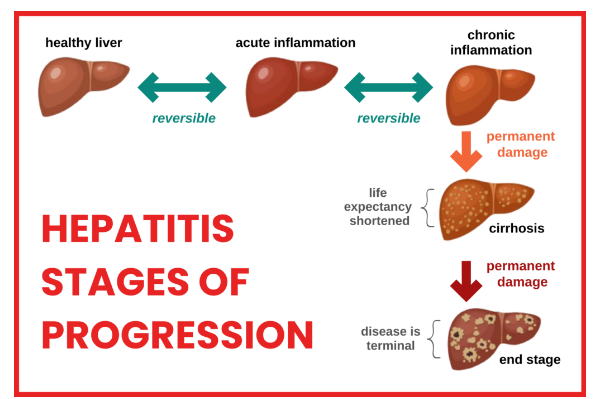Hepatitis is a medical condition characterized by liver inflammation, commonly caused by hepatitis viral (hepatitis A through E) infections. However, it can also arise from exposure to hepato-toxins, alcohol abuse, autoimmune diseases, and certain medications. Hepatitis is a significant global public health issue, affecting millions of people each year. Despite its widespread occurrence, many misconceptions about hepatitis persist, leading to stigma, inadequate care, and the spread of the disease.
According to the World Health Organization (WHO), India has the second highest prevalence of viral hepatitis globally. The National Center for Disease Control of 2021 estimates that about 10 million people in India are chronically infected with hepatitis B, with a prevalence rate of 0.68 to 1.16 per cent and for hepatitis C the prevalence is around 0.5 per cent.
Misconception 1: Hepatitis is a Single Disease
One of the misconceptions is that hepatitis is caused by one etiological agent. In reality, hepatitis is caused by five types of viruses named alphabetically as hepatitis A, B, C, D, and E. Each type of hepatitis has different modes of transmission, diagnostic blood tests, preventive strategies and treatment protocols.
- Hepatitis A is often transmitted through ingestion of contaminated food or water.
- Hepatitis B and C are primarily spread through contact with infectious body fluids, such as blood. Hepatitis B can also be spread through sexual contact.
- Hepatitis D occurs only in those infected with hepatitis B, as it requires the hepatitis B virus to replicate.[i]
- Hepatitis E is typically transmitted through consumption of contaminated water.
Misconception 2: Hepatitis Only Affects Drug Users and Sexually Active Individuals
Another significant misconception is that hepatitis primarily affects drug users or individuals with multiple sexual partners. While intravenous drug use and unprotected sex are risk factors, hepatitis can affect anyone. For example: Hepatitis B can be transmitted from mother to child during childbirth, making it prevalent in certain regions where vaccination is less common.
Hepatitis C can be contracted from blood transfusions, as the infection spreads when blood, unsafe injection, which allows the virus to enter the bloodstream of a previously uninfected person.[ii] Understanding that hepatitis can impact anyone, regardless of their lifestyle, is crucial for reducing myths and encouraging widespread testing and vaccination.
Misconception 3: Hepatitis B and C are Incurable
Advances in medical science have significantly improved the prognosis for those with hepatitis B and C. While there is no cure for hepatitis B, it can be effectively managed with antiviral medications, which can reduce viral load and prevent liver damage. Additionally, a vaccine is available to prevent hepatitis B infection.
Hepatitis C, once considered a chronic and progressive disease, is now curable in most cases. The introduction of direct-acting antiviral (DAA) medications has revolutionized treatment, leading to cure rates exceeding 90 per cent. Early detection and treatment are key to achieving these outcomes.
Misconception 4: Hepatitis Symptoms are Always Apparent
Hepatitis can often be a silent disease, especially in its early stages. Many individuals with chronic hepatitis B or C are asymptomatic, meaning they exhibit no symptoms for years or even decades. This asymptomatic nature can lead to delayed diagnosis and treatment, increasing the risk of severe liver damage, cirrhosis, and liver cancer.
Even when symptoms do appear, they can be nonspecific, such as fatigue, jaundice, dark urine, abdominal pain, and loss of appetite. Routine screening, especially for individuals in high-risk groups, is essential for early detection and treatment.
Misconception 6: Hepatitis B and C are Not Common in Developed Countries
Hepatitis B and C are serious health issues, not confined to developing countries. While higher prevalence rates are often seen in certain regions of Africa, Asia, and Eastern Europe, developed countries, including the United States and Western Europe, still face significant hepatitis B and C burdens. Factors such as migration, travel, and inadequate screening can contribute to the spread of these infections in developed nations.[iii]
Misconception 7: People with Hepatitis B or C Cannot get Married or Bear Children
This is a widespread concern amongst patients diagnosed with hepatitis B or C. Hepatitis B patients can have their partners vaccinated, and hepatitis C patients can achieve a complete cure with a short course of antiviral medications. Hepatitis B-positive mothers can safely go through pregnancy and their baby can be protected by a dose of hepatitis B immunoglobulin at birth and early vaccination. All pregnant women should be screened for the presence of hepatitis B and C, if not already known.
Myths and misinformation don’t have to stand in the way of good health. By understanding the facts about hepatitis, individuals can make informed decisions about prevention, testing, and treatment. One should talk to a healthcare provider for personalized guidance and support on this important health concern.
The author is the Executive Director – Gastroenterology, Fortis Escorts Liver & Digestive disease (FELDI), Okhla, New Delhi and Pro Chancellor, KIIT University, Bhubaneswar.























